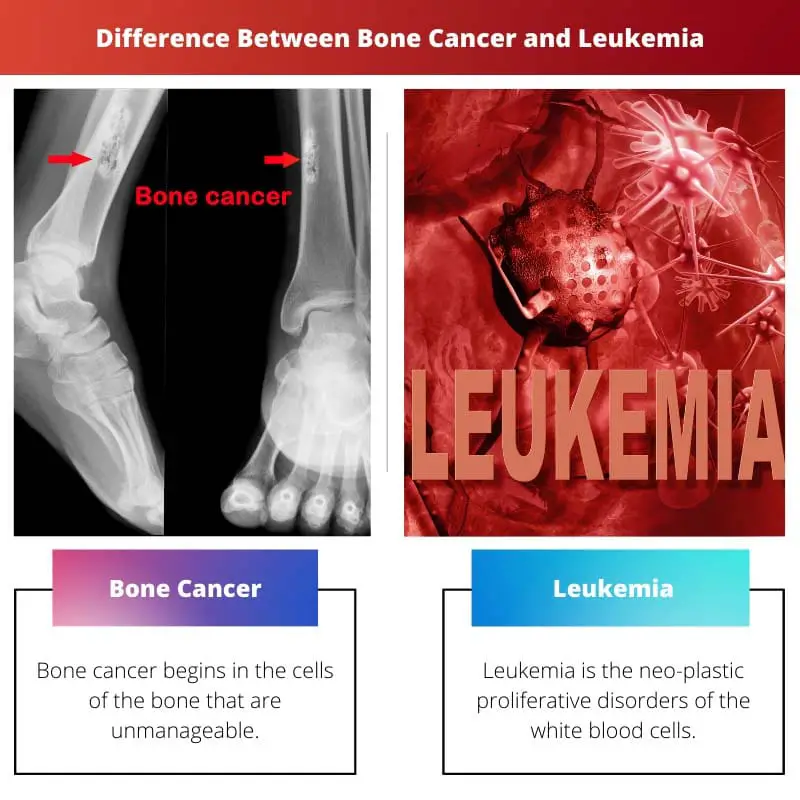Our bodies are made up of billions of cells, and these cells are constantly dividing, dying, and being replaced in a controlled way.
But cancer happens when a cell gets damaged while dividing, and the damaged cell might start to grow and multiply too much to form a tumour anywhere in the body.
If this continues, then it can grow into nearby tissues and spread to other parts of the body.
Different kinds of cancer have evolved concerning different parts of the body in the 21st century. Two of these kinds of cancer are Bone cancer and Leukemia (the cancer of the blood).
Key Takeaways
- Bone cancer originates in the cells of the bone, whereas leukemia starts in the blood-forming cells of the bone marrow.
- Bone cancer symptoms include localized pain and swelling, while leukemia symptoms may involve fatigue, frequent infections, and easy bruising.
- Treatment for bone cancer can include surgery, radiation, and chemotherapy, while leukemia treatment primarily involves chemotherapy, targeted therapy, and stem cell transplants.
Bone Cancer vs Leukemia
Leukaemia is a type of blood cancer which varies from it. Bone cancer, like fibrosarcoma or osteosarcoma, has a poorer prognosis compared to leukaemia. Bone cancer is best treated with surgery or amputation, while leukaemia is best treated with chemotherapy and bone marrow transplantation.

Bone cancer happens when a cell in the bone divides uncontrollably and forms a tumour. If the tumour remains confined and does not spread into surrounding tissues, then it is considered benign.
But if the tumour invades into surrounding issues and metastasizes or spreads through blood or lymph, then it is considered malignant.
Leukaemia occurs when malignant white blood cells multiply inside the body’s bone marrow. Usually, leukaemia involves the production of abnormal white blood cells that are responsible for combatting infection.
Leukaemia cells have quite mutations in their DNA that cause them to grow abnormally and lose the functions of typical white blood cells.
Comparison Table
| Parameters of Comparison | Bone Cancer | Leukemia |
|---|---|---|
| Definition | Bone cancer begins in the cells of the bone that are unmanageable. | Leukemia is the neo-plastic proliferative disorders of the white blood cells. |
| Affected area | It is the cancer of bone. | It is the cancer of blood-forming tissues. |
| Symptom | It causes excessive pain in the afflicted bone. | It hinders the body’s ability to combat infection. |
| Prognosis | Difficult | Relatively better when diagnosed on time |
| Treatment Method | Surgery or amputation | Chemotherapy or bone marrow transplantation |
| Common age group | Children and adolescents under 20 | People under 20 or over 55 |
What is Bone Cancer?
Bone cancer is cancer that eventuates in the bones. It is a pernicious illness and quite painful as it is concerned with bones.
This type of cancer happens when a cell in the bone grows out of control to divide and forms a tumour.
The most common sources of tumour cells that affect the bones but start somewhere else in the body are the breast, prostate, lungs, thyroid, and kidneys.
If the bone tumour does not spread into adjusting tissues, then it is benign (non-cancerous tumour) in nature, for example, enchondroma, osteochondroma, or giant-cell tumour of the bone (GCTB or osteoclastoma).
And if the tumour attacks those encircling tissues and spreads through blood or lymph, then it is malignant.
Malignant tumours can be primary, which is when they arise from the bone cells, for example, osteogenic-sarcoma, or secondary, which is when a tumour developed
somewhere else in the body and spread to the bone, for example, fibrosarcoma.
These types of cancer are quite intractable to make an accurate prognosis.
Benign tumours can be surgically removed if they are causing symptoms, while the treatment for malignant tumours requires radiotherapy, chemotherapy, and surgery. These therapies might respond poorly to the complexity.
An alternative for the same can be amputation which will cure the disease completely if the cancelled cells propagate to other bones.

What is Leukemia?
Leukaemia is a neo-plastic disorder of white blood cells proliferative. It is a type of blood cancer that begins in stem cells found in the bone marrow.
When it occurs, the damaged cells reproduce in the blood and the bone marrow until they cover all available space and resources.
When the bone marrow cannot produce a sufficient amount of functional cells anymore, the blood gets consumed.
The lack of red blood cells portrays that the dearth of functional white blood cells affects the immune system enhancing the risk of infections.
To restore the normal function of the blood, leukemic cells have to be taken out. As leukaemia is not a solid tumour, thus, cells are killed inside the body using many treatments like chemotherapy instead of surgery.
Another method is bone marrow transplantation which comes in the form of stem cells from the bone marrow of a donor.
But chemotherapy has the side effect of killing healthy cells along with the damaged cells, and sometimes it leads to the destruction of all the cells in the bone marrow.
Also, bone marrow transplants are a complicated process requiring antigen compatibility between the donor and recipient to keep the transplanted cells from attacking the patient’s cells as foreign bodies.

Main Differences Between Bone Cancer and Leukemia
- Bone cancer is related to the cells of bone, while Leukemia is the cancer of blood-forming tissues involving white blood cells.
- It causes pain in the afflicted bone. On the other hand, it affects the body’s ability to fight against infection.
- The prognosis of bone cancer is very difficult, but that of leukaemia is possible when diagnosed on time.
- Bone cancer is chiefly treated with surgery or amputation, while leukaemia can be treated with chemotherapy or bone marrow transplantation.
- Bone cancer is commonly diagnosed in people under 20 or above 55. Leukaemia mostly affects people under 20, especially children.




